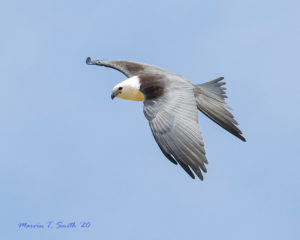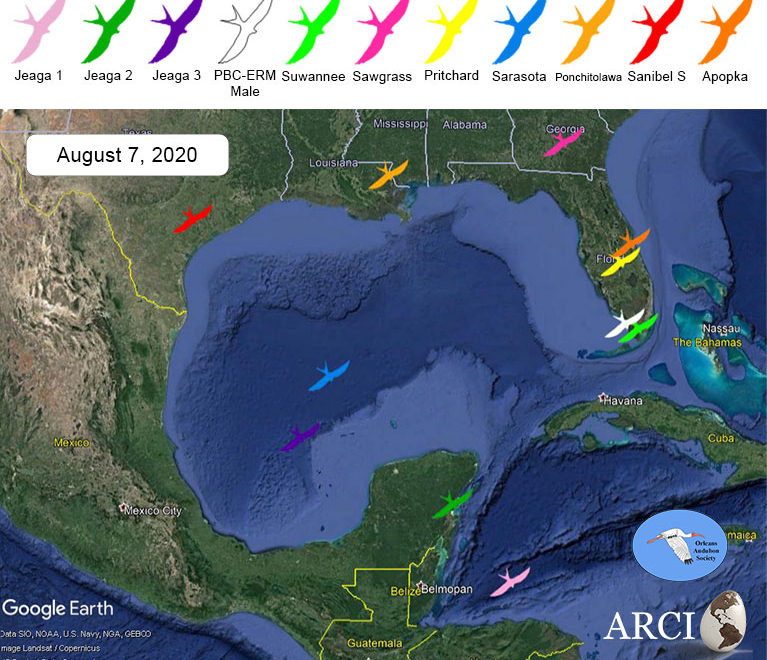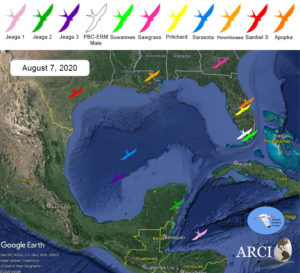As of August 7th 2020, our GPS-tagged Swallow-tailed Kites have made leaps and bounds on their migration. Recall that Hurricane Isaias moved up the Atlantic coast, and the winds and pressure systems surely encouraged many Swallow-tailed Kites to take advantage of the tailwinds. All but two of the 11 tracked kites have moved south.
Ponchitolawa, tagged by colleague Dr. Jennifer Coulson of Orleans Audubon, is still foraging around the Pearl River in Louisiana, and Apopka is still along the southern reaches of the St. Johns River, in Brevard, County Florida.
Sawgrass from Pinellas County, Florida, has left the Savannah River near Augusta, Georgia and is now on the Altamaha River near Abbeville, Georgia.
Pritchard also left the Savannah River, spent a night south of Jacksonville, Florida, and is now in Highlands County, Florida.
After staying aloft for nearly five days over the Gulf of Mexico, Sanibel South has been moving slowly around Dewitt County, Texas.
Suwannee had spent a night in Florida’s Green Swamp, another in Picayune Strand State Forest in Collier County, Florida, and continues moving southward through the Everglades. We assume he will be crossing the Gulf of Mexico any time now. PBC-ERM Male is lingering on the southern tip of Florida’s Cape Sable, waiting to cross the Yucatan Channel.
Four kites have made the “leap” from south Florida! Jeaga 2, followed just a day later by Jeaga 1, crossed south to Cuba spending two and three nights, respectively, before making quite different departures from the Island. Jeaga 2 left for the Yucatan from western-most Cuba and made good time to an arrival just south of Cancun, Mexico. Jeaga 1 departed from the south-central Cuban coast heading southwest, crossed the Cayman Islands, and is on course over the Caribbean to make landfall between Belize and Honduras soon, if the wind doesn’t switch directions.
Jeaga 3 made a fast trip through south Florida and caught up with Sarasota on Cape Sable, Florida. They both left the southern tip of Florida within hours of each other, but their paths have been distinctly different. Jeaga 3 flew to western Cuba and spent one night on the Guanahacabibes Peninsula before departing for Mexico. Winds derailed a direct flight to the Yucatan, so, just like Sanibel South, Jeaga 3 was pushed westward into the central Gulf of Mexico. Meanwhile, Sarasota crossed the Florida Keys towards the Yucatan Peninsula, but, just like Sanibel South and Jeaga 3, was pushed westward by tailwinds into the central Gulf.
 |
| Juvenile Swallow-tailed Kite photo by Marvin Smith |
All this means three GPS-tracked Swallow-tailed Kites are now over open ocean, at the mercy of winds in this region of volatile weather! As Sanibel South showed us, a kite can survive up to 5 days over water without food and rest, but the average maximum time over water has been three days.
If you’ve been following along with ARCI’s Swallow-tailed Kite migration blogs over the years, you have witnessed how these birds are putting a lot on the line as they make the attempt to cross at least 400 miles of ocean to reach the Yucatan Peninsula. However, they need the support of tailwinds and, as we all have learned, anything can happen.
Fingers crossed for all Swallow-tailed Kites to make it safe to land. More soon!
As always, we are grateful to all of the organizations and individuals who have made ARCI’s long-term studies of Swallow-tailed Kites possible, thus helping us understand how these amazing birds need our help. The ever-growing list of current contributors includes:
Audubon Center for Birds of Prey
bioGraphic
Caloosa Bird Club
Clearwater Audubon Society
CROW – Clinic for the Rehabilitation of Wildlife, Inc.
Florida Panther National Wildlife Refuge
Friends of Palmetto Bluff Conservancy
Friends of the Carlton Reserve
Friends of the Florida Panther Refuge
Friends of the Lower Suwannee & Cedar Keys National Wildlife Refuges
Halifax River Audubon
Jacksonville Zoo and Gardens
Lower Suwannee National Wildlife Refuge
National Audubon Society
Oklawaha Valley Audubon Society
Orange Audubon Society
Orleans Audubon Society
Palm Beach County Department of Environmental Resources Management
Palm Beach Zoo and Conservation Society
Palmetto Bluff Conservancy
Peace River Audubon Society
Sanibel-Captiva Audubon Society
Sanibel-Captiva Conservation Foundation SCCF
Sarasota Audubon Society
Seminole Audubon Society



Leave a Reply